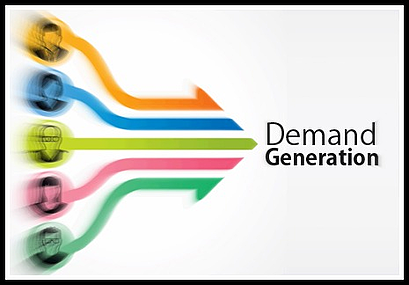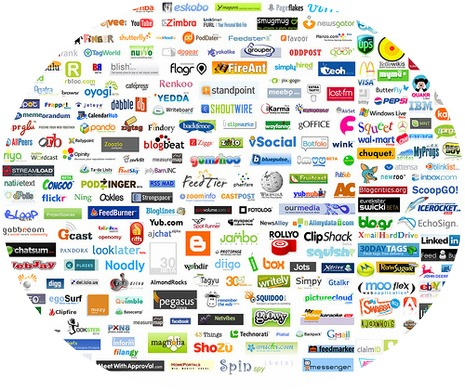Marketing Strategies: Demand Generation vs. Lead Generation

Updated Jan. 2023
How many of you, business people out there, are confused about the difference between lead generation and demand generation? Raise your hands; don’t be shy. There is a distinct difference between these marketing strategies even though some marketing agencies use them both interchangeably or use the wrong one. Here’s a clue: one is focused on changing your clients’ perspective and the one wants to capture their information for you to follow up with.
Definitions
Let’s start with some marketing strategies definitions I found helpful from an article by Eric Wittlakes, Lead Generation is Crippling Demand Generation:
- Lead generation: collecting registration information, often in exchange for content, in order to build a marketing database for email or telemarketing follow-up. The direct outcome of lead generation is new contacts available for sales or marketing.
- Demand generation: the practice of creating demand for an organization’s products or services through marketing. The direct outcome is your audience is more likely to purchase your products or services.
Another marketing strategy definition of demand generation comes from Eloqua.com. “Demand generation is the art and science of creating, nurturing, and managing buying interest in your products and services through campaign management, lead management, marketing analysis, and data management.”
These make the most sense of everything I read. Getting leads is growing your lists, which is the way we tend to view general marketing practices, and is a part of demand generation marketing. On the other hand, demand generation means creating interest in your product so that people want it. Think in terms of the different ways diet drinks work to sell their products to all sorts of demographics. When I wonder who an ad is aimed at, I have not been considering that the intention behind the ad may be to create demand for the product.
Why is a Distinction Necessary?
Why the distinction at all? Demand Generation vs. Traditional Marketing Agencies by the Inbound Sales Network says, “In today’s business world, more and more companies now hold marketing accountable for revenue contribution or quota; in many cases, they are doing this for the first time.”
If you are a business expecting to outsource your marketing, you might look for an agency whose marketing strategies help you increase potential client demands for your product before you begin qualifying leads. Or you might want to work with the agency to develop marketing strategies to get some qualified leads before doing a broadcast of your product.
Whittlakes explains that lead generation marketing strategies focus on content, blogs, Facebook Pages, Twitter, and whitepaper—all things that an agency uses to capture client information on a registration form. They create a demand for the content, not the product. The primary purpose of these tactics is to only give your content to more qualified leads, the ones who show extra interest by filling in a form.
So, which strategies are the best option?
What Are the Most Effective Demand Generation Strategies?
Creating demand for your product or service is essential for any successful business. But with so many different methods of demand generation out there, it can be hard to know which ones are the most effective. Here is a list of some of the most effective strategies for generating demand and how they can help your business grow. From building a strong online presence to creating content that appeals to your target audience and beyond, discover what tactics you need to implement in order to increase sales and revenue.
The first step is understanding how each type of lead generation impacts your marketing efforts. In simple terms, demand generation is any combination of marketing techniques that get you noticed, increasing the demand for your products or services. There are a number of different demand generation strategies that can be effective, depending on the product or service being offered and the target market. However, some common demand generation tactics include content marketing, search engine optimization (SEO), brand awareness, thought leadership, guest posts, and providing free resources to those who come to your website.
Content marketing is a type of demand generation that focuses on creating and distributing relevant, consistent, and valuable content that both attracts and retains your audience — ultimately driving customer actions that lead to profits. SEO is another common demand generation strategy that helps improve the organic visibility of a website or blog in search engines like Google, Bing, Duck Duck Go, and Yahoo. By optimizing site content for the right keywords and phrases, businesses can attract more qualified visitors who are likely to convert into leads or customers.
Brand Awareness
There are many demand-generation strategies that can be effective for your business, but brand awareness is one of the most important. Increasing brand awareness can help you attract more customers and grow your business.
One way to increase brand awareness is to create a strong online presence. This can be done by optimizing your website for search engines, creating informative blog content, and using social media to reach a wider audience. You can also increase brand awareness by participating in trade shows and events, and by advertising in traditional media outlets.
Thought Leadership
Thought leadership is a process of deciding where the dialog is going instead of following the trends. When you know your industry, you can predict what the future will hold with some confidence. That allows you to speak in a manner that is different than others who do not understand the industry as well. By using thought leadership, you make people think. You become that authority that everyone is looking for, which increases both brand awareness, and the demand for your time.
Guest Posts
One great way to generate demand is through guest posting. Guest posting involves writing articles for other blogs in your industry or niche. This is a great way to get your name and your brand out there in front of new people. Not only will you be getting exposure to a new audience, but you'll also be able to build relationships with other bloggers in your industry. You also get the secondary benefit of getting backlinks from the blogs that let you write for them with a link back to your own business website.
Free Resources
When you want to get the word out there about your brand, offering free resources is a great way of doing it. Some simple ideas include infographics, e-books, and comparison sheets. They allow your customers or potential leads to get something quick and valuable that keeps your company, products, and services top of mind. They are typically easy things to put together, but they come from a place where knowledge is the value that these customers seek, so they provide answers and begin establishing trust.
What Are the Most Effective Lead Generation Strategies
Generating leads is an essential part of any successful business. It’s the foundation upon which most sales are built. But if you’re not actively pursuing lead generation strategies, you’re likely missing out on some major opportunities. Without an effective lead generation strategy, your business can quickly become stagnant and unprofitable. To avoid this, it's important to have a good understanding of the top lead generation strategies and how to make them work for your business.
Basically, lead generation is the process of generating leads, or potential customers, for a business. There are a number of lead-generation strategies that businesses can use to generate leads, and the most effective lead-generation strategy will vary depending on the business and its target market. However, some common lead generation strategies include content marketing, search engine optimization (SEO), gated content, creating shareable content, direct mail marketing, and webinars.
Search Engine Optimization
Search Engine Optimization, or SEO, is one of the most effective lead-generation strategies. By optimizing your website for search engines, you can increase your organic visibility and attract more visitors, which can lead to more leads and sales.
To optimize your website for search engines, you need to choose the right keywords. Keywords are those words or short phrases customers type into their search engines when they want to find products or services that relate to you. Once you have chosen the right keywords, you need to include them in your website content in a way that is both Search engine friendly and user-friendly.
Gated Content
Gated content is a type of content that can only be accessed by completing a form. The form then requires the user to provide their contact information, such as their name and email address. Once the form is completed, the user is then able to access the content.
Gated content can be an effective lead-generation strategy because it allows you to capture leads that are interested in your content. By requiring users to complete a form, you can gather valuable information about your leads that you can use to nurture them through the sales process. Additionally, gated content can help you to qualify your leads, as those who are willing to provide their contact information are typically more serious about doing business with you.
Creating Sharable Content
There's no doubt that lead generation is essential to the success of any business. But with so many different strategies out there, it can be tough to know which ones are right for you.
One of the most effective lead generation strategies is creating sharable content. This could be in the form of infographics, videos, white papers, or anything else that would be valuable to your target audience.
The key is to create content that is truly useful and shareable. If it's something that people will find helpful, they're much more likely to share it with their networks. And that's how you'll generate leads.
Direct Mail Marketing
Direct mail marketing is one of the most effective lead-generation strategies. It allows you to target your audience with a physical piece of mail that they can hold in their hands and interact with. This type of marketing allows you to connect with your audience on a personal level and build a relationship with them.
One of the best things about direct mail marketing is that it is highly targeted. You can target specific demographics, geographic areas, or even interests. This ensures that your message is reaching the right people and that you are not wasting your time and money on marketing to people who are not interested in what you have to say.
Another great thing about direct mail marketing is that it is relatively inexpensive. You can reach a large number of people for a very reasonable price. This makes it a great option for small businesses or those just starting out.
Overall, direct mail marketing is an extremely effective lead-generation strategy that should be considered by all businesses. It is highly targeted, relatively inexpensive, and can be very personal. However, it does require some time and effort to get started.
Webinars
Webinars are an effective lead generation strategy because they provide an opportunity for you to present your company and its products or services in a professional setting. They also allow you to build relationships with potential customers by providing valuable information that they can use to make informed decisions about their purchase decisions.
How Do You Bring Lead Generation and Demand Generation Together?
Lead generation and demand generation are two of the most important aspects of any business’s marketing strategy. When used effectively, they can drive sales, build customer relationships, and increase brand visibility. But how can you bring these two elements together to form a comprehensive plan? A thorough analysis of both processes helps to show the benefits and challenges posed by each, as well as the potential solutions for unifying them into a single cohesive strategy.
How to Bring Lead Generation and Demand Generation Together
Lead generation and demand generation are two important aspects of any successful marketing strategy. When used together, they can help you create a well-rounded approach that will attract and convert more leads. Here are a few tips on how to bring lead generation and demand generation together:
- Define your target market: This is the first step in any successful marketing strategy. You need to know who you're targeting before you can start generating leads. Take some time to research your target market and identify their needs. You need this vital piece of information before you begin either type of lead generation.
- Create compelling content: Once you know who you're targeting, you can start creating content that will appeal to them. This could include blog posts, eBooks, infographics, or even videos. The key is to create content that is valuable and interesting enough to get attention. As you create your online presence, make sure you also consider how sharable the content is, and if the content is following the trends, or setting them.
- Promote your content: Once you have some great content, it's time to promote it! There are a number of ways to do this, including email marketing, social media, and paid advertising. Always make sure to promote your content in places where your target market is likely to see it.
- Convert your leads: After all your hard work generating leads, it's time to convert them into customers! Offer something of value in exchange for their contact information, such as an eBook or coupon code. Then follow up with them regularly until they're ready to buy from you.
The Benefits of Bringing Lead Generation and Demand Generation Together
When these two disciplines are brought together, the result is a well-oiled machine that can generate leads and convert them into customers at an unprecedented rate. There are many benefits to bringing lead generation and demand generation together.
Perhaps the most obvious benefit is that it allows you to create a streamlined process for acquiring new customers. By having a system in place that can generate leads and then nurture them through the sales funnel, you’ll never have to worry about where your next customer is coming from.
In addition to generating new customers, another key benefit of integrating lead generation and demand generation is that it can help you better understand your target market. By understanding the needs and wants of your ideal customer, you can create targeted content and offer relevant products or services that will appeal to them. This level of customization is impossible to achieve without a robust understanding of your target market, which is only possible when you bring lead generation and demand generation together.
Ultimately, the benefits of integrating lead generation and demand generation are numerous and varied. By streamlining the customer acquisition process, gaining a better understanding of your target market, and increasing conversion rates, you’ll be able to take your business to the next level.
To Capture or Not to Capture
Marketing strategies made up of demand generation use content marketing, but with a different intended result. The result is to educate the audience and shape their perspectives and positions on your product. Since you want this to be distributed broadly, the content is given to all freely without requesting information, a barrier that demand generation marketing doesn’t want. “In other words, maximizing demand generation requires removing registration capture, and therefore lead generation, from the primary flow,” he says.
It is possible to use both in a marketing strategies plan such as the one Eloqua states in their definition above, but they cannot both be combined into a single process. Demand-generation marketing programs typically rely on some form of proactive lead-generation activities supported by more traditional market programs and processes. Perhaps you, like me, have confused lead generation with demand generation. Converting demand into sales is a totally separate task.
The relation
Now that we have good, solid definitions of demand generation and lead generation, it becomes clear to us that there are marked differences between marketing strategies. However, they’re closely related, with each side in need of the other.
“The traditional view calls for a fairly distinct separation between the two, with demand generation typically handled by marketing — brand awareness, overall interest creation, positioning, etc. — and lead generation handled by sales — lead qualification and follow-up leading to sales engagement,” says Micky Long, vice president and practice director of lead nurturing at integrated B2B public relations and marketing consultancy Arketi Group.
“While both are about delivering a relevant and differentiated message to groups of prospects to build an ongoing connection, the main difference is that demand-generation activities address entire groups of prospects while lead-generation activities are designed to identify and nurture individual prospects.” Long adds that today’s tools and technology blur the lines between the two sides.
And now you know.
If you need some help creating the correct marketing strategies, we at BroadVision Marketing are here to help.
If you have done some demand generation marketing, how did it work for you. Please leave a comment because your idea may help someone else.
JJaco Grobbelaar is the co-owner of BroadVision Marketing. BroadVision Marketing works primarily with business owners who struggle to improve their organizations' online visibility and to put in place inbound marketing strategies that consistently secure new qualified prospects. BroadVision Marketing primarily serves companies in the USA.
Jaco can be reached at jaco@broadvisionmarketing.com or 707.766.9778 or connect with Jaco on Facebook - www.facebook.com/broadvisionmarketing - and LinkedIn - www.linkedin.com/in/JacoGrobbelaar.
You May Also Like
These Related Stories

Marketing Strategies: Demand Generation vs. Lead Generation

Efficient Marketing: Outsourcing Lead Generation



No Comments Yet
Let us know what you think